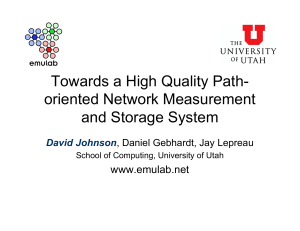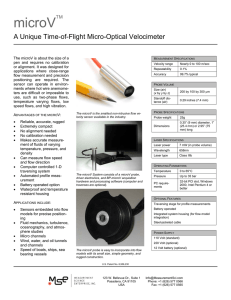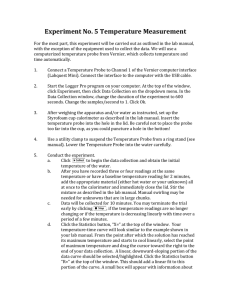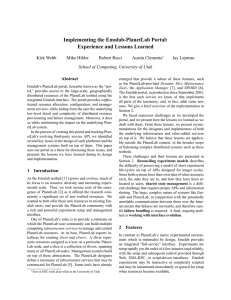Towards a High Quality Path- oriented Network Measurement and Storage System www.emulab.net
advertisement
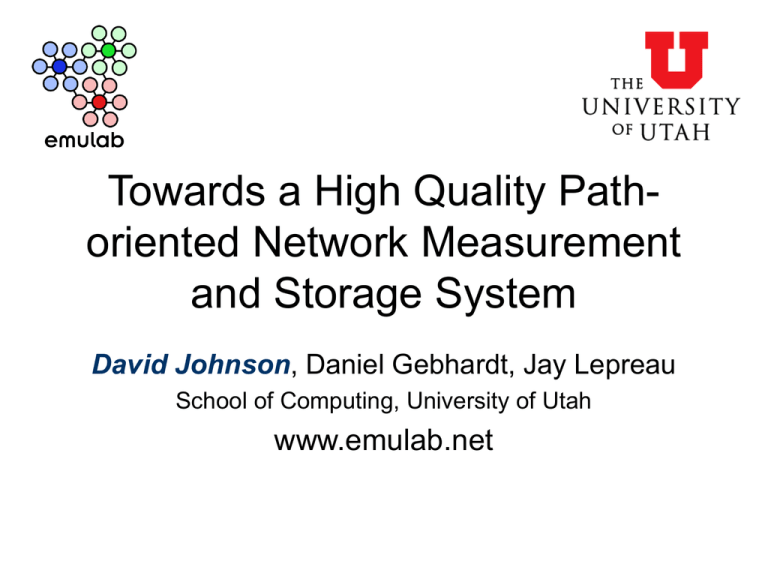
Towards a High Quality Pathoriented Network Measurement and Storage System David Johnson, Daniel Gebhardt, Jay Lepreau School of Computing, University of Utah www.emulab.net Different Goals for our NMS • Many uses for Internet-scale path measurements: – Discover network trends, find paths – Building network models – Run experiments using models and data • A different design point on the NMS spectrum: – – – – – Obtain highly accurate measurements … from a resource-constrained, unreliable network … for multiple simultaneous users … sometimes at high frequency ... and return results fast and reliably 2 Flexlab: a Motivating Use Case • Problem: real Internet conditions matter, but can make controlled experiments difficult • Flexlab [NSDI 07]: integrate network models into emulation testbeds (i.e., Emulab) – Example: network models derived from PlanetLab • How it works: – Measure Internet paths in real time – Clone conditions in Emulab 3 Requirements • Shareable – Anticipate multiple users – Frequent simultaneous probing can cause selfinterference, and increase cost – Amortize cost of measurements by removing probe duplication across users • Reliable – Reliably buffer, transmit, and store measurements – Probing & storage should continue when network partitions disrupt control plane 4 Requirements, cont’d • Accurate – Need best possible measurements for models • Safe – Protect resource-constrained networks and nodes from probing tools, and vice versa • And yet support high freq measurements – Limit BW usage, reduce probe tool CPU overhead • Adaptive & controllable – Function smoothly despite unreliable nodes – Modify parameters of executing probes 5 Hard System To Build! • End-to-end reliability – Data transfer and storage, control – PlanetLab: overloaded nodes, sched delays • Measurement accuracy vs resource limits • => We’re not all the way there yet 6 Flexmon • A measurement service providing shared, accurate, safe, reliable wide area path-oriented measurements – Reliable probing and results transfer & storage atop unreliable networks and nodes – Accurate, high freq measurements for multiple users despite network resource limits – Transfers and exports results quickly and safely • Not perfect, but good start • Deployed on an unreliable network, PlanetLab, for 2+ yrs • Nearly 1 billion measurements • Data available publicly via multiple query interfaces and the Web 7 Flexmon Overview Manager Client Manager Client XML-RPC Server • Path Probers schedule Manager Client and run probes Auto-Manager • Client Reliably store Manager and forward requests a probe Write-back results to central collector • User • Manager performs Cache Datapository viasafety a Manager Client • The Data Collector checks on request checks results and stores and forwards to a set of • Users query cache DB, Data Path Path them in a cache Path Probers Path long-term Datapository, Prober Prober Collector Prober are moved • Cached results or XML-RPC server to permanent storage in the Datapository 8 User Interface • Authentication through Emulab • Users request probes through manager clients – Type of probe, set of nodes, frequency and duration, and other tool-specific arguments – Users can “edit” currently executing probes to change parameters • Get measurements from caching DB via SQL 9 Central Management • Manager applies safety checks to client probe requests: – Reject if probe request is over frequency and duration thresholds – Can reject if expected bandwidth usage will violate global or per-user limits • Estimates future probe bandwidth usage based off past results in write-back cache 10 Background Measurements • The Auto-manager Client requests all-pairs probing for one node at each PlanetLab site – Assumption: all nodes at a site exhibit “identical” path characteristics to other sites – Chooses least loaded node at each site to avoid latencies in process scheduling on PlanetLab • Assesses node liveness and adjusts node set • Uses low probe duty cycle to leave bandwidth for high-freq user probing 11 Probing • A Path Prober on each node receives probe commands from the Manager • Spawns probe tools at requested intervals – Newer (early) generic tool support, although safety not generalized • Multiple probe modes to reduce overhead – One-shot: tool is executed once per interval, returns one result – Continuous: tool is executed once; returns periodic results 12 Probing, cont’d • Probers maintain a queue of probe commands for each probe type and path, ordered by frequency – Serially execute highest-frequency probe – All users get at least what they asked for, maybe more • Trust model: only allow execution of approved probing tools with sanity-checked parameters • Currently use two tools – fping measures latency • Attempts to distinguish loss/restoration of connectivity from heavy packet loss by increasing probing frequency – Modified iperf estimates ABW 13 Collecting & Storing Measurements • Probers send results to central data collector over UDP – Stable commit protocol on both sides – Collector drops duplicate results from retransmits • Not perfectly reliable – i.e., cannot handle node disk failures • Use write-back cache SQL DB for perf • Newest results in write-back cache are flushed hourly to long-term storage in Datapository – Fast stable commit 14 Searching the Data • “Write-back cache” SQL DB – Available to Emulab users by default – Fast but limited scope • Datapository containing all measurements – Access upon request – Weekly data dumps to www • XMLRPC server – Can query both DBs over specific time periods – More expressive query power (i.e., FullyConnectedSet, data filtering, etc) 15 Deployment & Status • Probers run in an Emulab experiment, using Emulab’s portal to PlanetLab • Managers, clients, and data collectors run on a central Emulab server – Use secure event system for management • Running on PlanetLab for over 2 years – Some architecture updates, but largely unchanged over past year – Some system “hiccups” – i.e., our slice has been bandwidth-capped by PlanetLab – Set of monitored nodes changes over time 16 Measurement Summary • Many measurements of pairwise latency and bandwidth • Latency measurements are 89% of total – 17% are failures (timeouts, name resolution failures, ICMP unreachable) • Available bandwidth estimates are 11% – Of these, 11% are failures (mostly timeouts) 17 PlanetLab Sites • Logfile snapshot of 100-day period • Median of 151 sites • System “restart” is the big drop 18 Node Churn • Typically 250-325 nodes in slice • Churn: number of newly unresponsive nodes at periodic liveness check 19 Brief Look at Some Data • 24-hour snapshot from Feb – 100k+ ABW samples; 1M+ latency samples • Latency vs bandwidth: curve approx BDP – Outliers due to method 20 Related Work • S3: scalable, generic probing framework; data aggregation support – We need fast & reliable results path – Need support to limit probe requests when necessary – Also need adaptability for background measurements • Scriptroute: probe scripts executed in safe environment, in custom language – No node-local storage, limited data output facilities • Others that lack shareability or reliable storage path; see paper 21 More To Be Done… • More safety – LD_PRELOAD, libpcap to track usage toolagnostically at probe nodes – distributed rate limiting [SIGCOMM ’07]; scale probe frequency depending on use • Add another user data retrieval interface (pubsub would be nice) • Increase native capabilities of clients – Adaptability, liveness 22 Conclusion • Developed an accurate, shareable, safe, reliable system • Deployed on PlanetLab for 2+ years • Accumulated lots of publicly-available data 23 Data! • http://utah.datapository.net/flexmon – Weekly data dumps and statistical summaries • Write-back cache DB available to Emulab users • SQL Datapository access upon request; ask testbed-ops@flux.utah.edu 24
